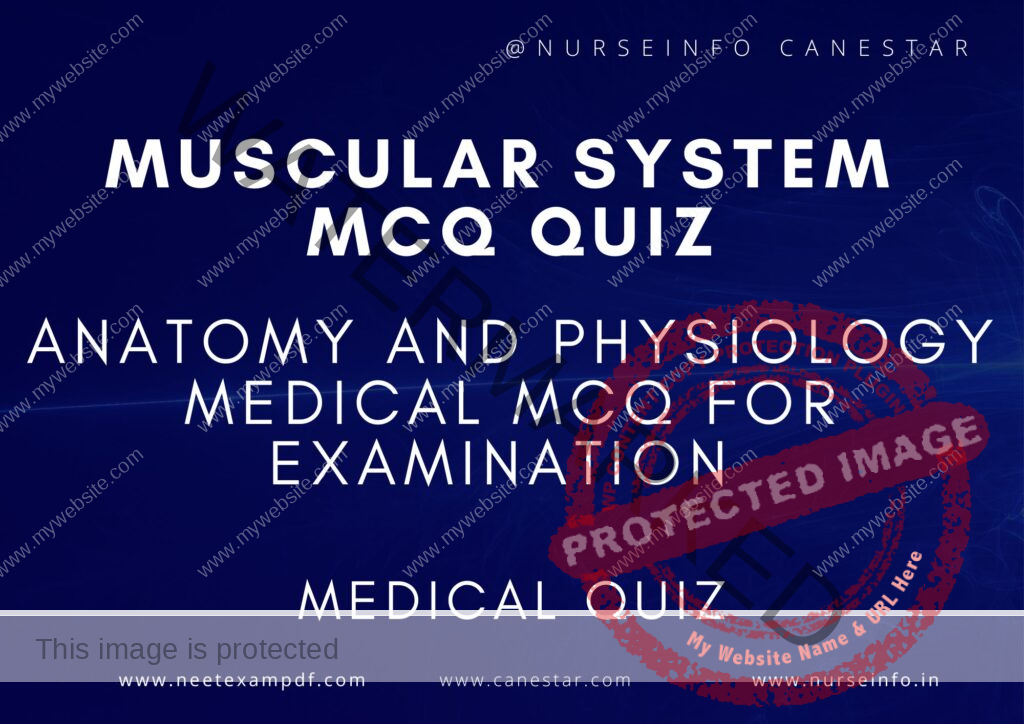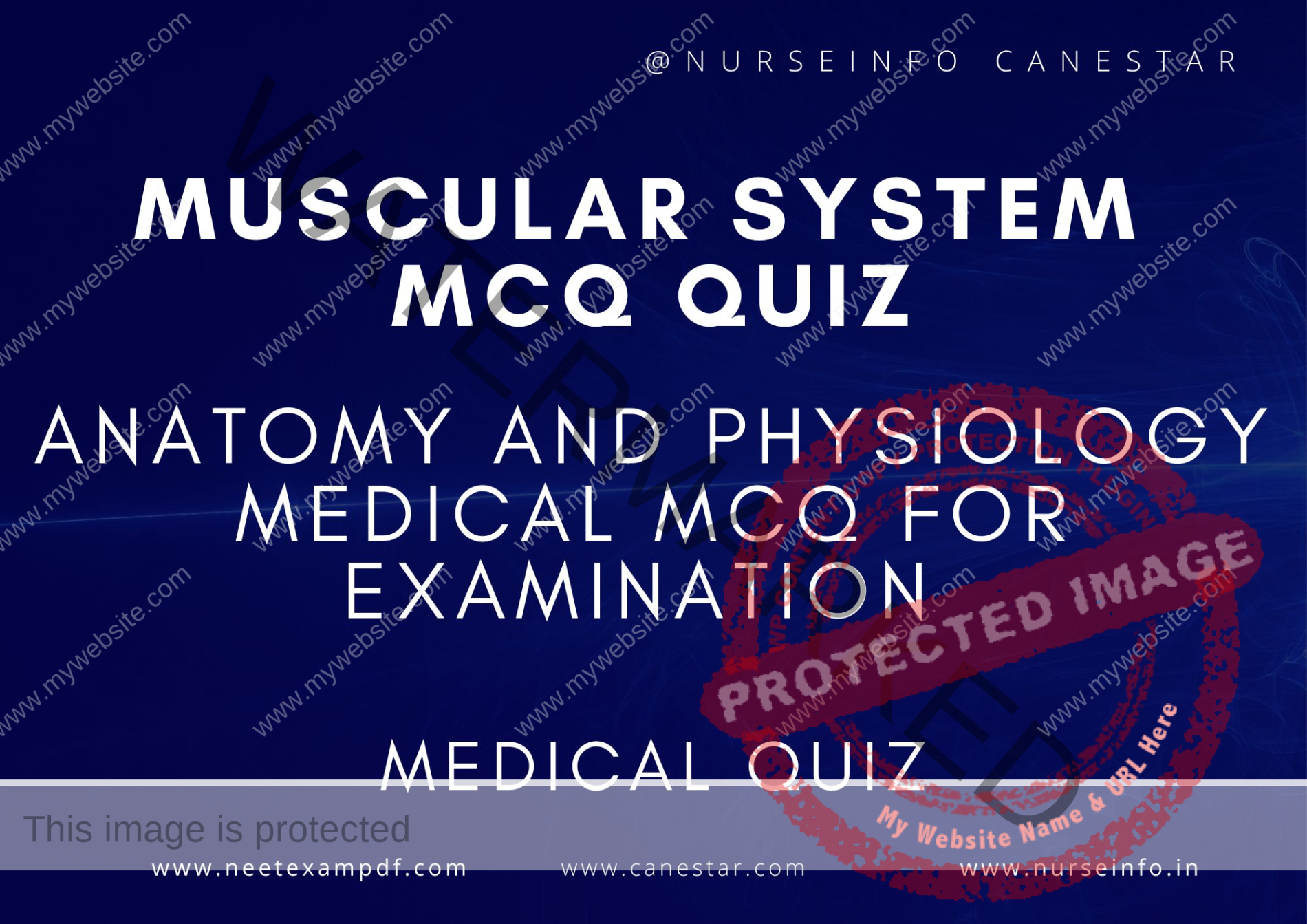MULTIPLE CHOICE QUESTIONS ON MUSCULAR SYSTEM QUIZ – MCQS WITH RATIONALE ANSWER – ANATOMY AND PHYSIOLOGY MCQ QUESTIONS
MCQ FOR MUSCULAR SYSTEM QUIZ
These mcqs are prepared exclusively for medical professionals for exam preparation. MCQ is helpful to remember the concept on muscular system mcq quiz. This multiple choice questions are helpful for preparation for DHA, PROMETRIC, MOH, HAAD, NCLEX, Medical, NEET and Nursing EXAMINATION
Question 1:
Which type of muscle tissue is found in the walls of hollow organs like the stomach and intestines? A. Skeletal muscle
B. Cardiac muscle
C. Smooth muscle
D. Voluntary muscle
Answer: C. Smooth muscle
Rationale: Smooth muscle tissue is found in the walls of hollow organs and is responsible for involuntary movements such as peristalsis in the intestines.
Question 2:
What is the primary function of skeletal muscles? A. Pumping blood throughout the body
B. Producing voluntary movements
C. Regulating blood pressure
D. Digesting food
Answer: B. Producing voluntary movements
Rationale: Skeletal muscles are attached to bones and control voluntary movements such as walking, typing, and facial expressions.
Question 3:
Which protein in muscle fibers is responsible for the binding of oxygen? A. Hemoglobin
B. Myosin
C. Myoglobin
D. Actin
Answer: C. Myoglobin
Rationale: Myoglobin is a protein in muscle fibers that binds to oxygen, allowing for efficient storage and usage of oxygen in muscle cells.
Question 4:
Which of the following is not a function of the muscular system? A. Movement
B. Heat production
C. Hematopoiesis
D. Posture maintenance
Answer: C. Hematopoiesis
Rationale: Hematopoiesis is the formation of blood cells, which occurs in the bone marrow, not the muscular system. The muscular system is responsible for movement, heat production, and posture maintenance.
Question 5:
Which type of muscle is under voluntary control? A. Cardiac muscle
B. Smooth muscle
C. Skeletal muscle
D. Involuntary muscle
Answer: C. Skeletal muscle
Rationale: Skeletal muscles are under voluntary control, meaning they are consciously controlled by the nervous system.
Question 6:
What is the name of the connective tissue that surrounds an entire muscle? A. Endomysium
B. Perimysium
C. Epimysium
D. Sarcolemma
Answer: C. Epimysium
Rationale: The epimysium is the outer layer of connective tissue that surrounds an entire muscle, providing protection and structure.
Question 7:
During muscle contraction, which ion is released from the sarcoplasmic reticulum to initiate the process? A. Sodium
B. Potassium
C. Calcium
D. Magnesium
Answer: C. Calcium
Rationale: Calcium ions are released from the sarcoplasmic reticulum and bind to troponin, initiating the muscle contraction process.
Question 8:
Which of the following muscle proteins forms the thin filaments in muscle fibers? A. Myosin
B. Actin
C. Tropomyosin
D. Troponin
Answer: B. Actin
Rationale: Actin is the protein that forms the thin filaments in muscle fibers and interacts with myosin during muscle contraction.
Question 9:
Which muscle type has intercalated discs? A. Skeletal muscle
B. Smooth muscle
C. Cardiac muscle
D. None of the above
Answer: C. Cardiac muscle
Rationale: Cardiac muscle cells are connected by intercalated discs, which facilitate synchronized contraction of the heart muscle.
Question 10:
What is the role of acetylcholine in muscle contraction? A. It breaks down ATP
B. It binds to myosin
C. It transmits nerve impulses to the muscle
D. It releases calcium ions
Answer: C. It transmits nerve impulses to the muscle
Rationale: Acetylcholine is a neurotransmitter that transmits nerve impulses to muscle fibers, triggering the contraction process.
Question 11:
The primary energy source for muscle contraction is: A. Glucose
B. Fatty acids
C. ATP
D. Glycogen
Answer: C. ATP
Rationale: ATP (adenosine triphosphate) is the primary energy source used by muscle cells during contraction.
Question 12:
Which type of muscle fiber is most resistant to fatigue? A. Type I (slow-twitch)
B. Type IIa (fast-twitch, oxidative)
C. Type IIb (fast-twitch, glycolytic)
D. None of the above
Answer: A. Type I (slow-twitch)
Rationale: Type I (slow-twitch) muscle fibers are more resistant to fatigue and are used for endurance activities.
Question 13:
Which muscle is responsible for the flexion of the forearm? A. Triceps brachii
B. Biceps brachii
C. Deltoid
D. Pectoralis major
Answer: B. Biceps brachii
Rationale: The biceps brachii muscle is responsible for flexing the forearm at the elbow joint.
Question 14:
Muscle hypertrophy refers to: A. Muscle shrinkage
B. Increase in muscle size
C. Increase in muscle length
D. Muscle soreness
Answer: B. Increase in muscle size
Rationale: Muscle hypertrophy is the increase in muscle size due to exercise and other stimuli.
Question 15:
The sliding filament theory explains muscle contraction based on the interaction between: A. Actin and myosin
B. Myoglobin and hemoglobin
C. Tropomyosin and troponin
D. ATP and glucose
Answer: A. Actin and myosin
Rationale: The sliding filament theory describes how actin and myosin filaments slide past each other to produce muscle contraction.
Question 16:
Which of the following is a primary muscle of respiration? A. Rectus abdominis
B. Diaphragm
C. Latissimus dorsi
D. Trapezius
Answer: B. Diaphragm
Rationale: The diaphragm is the primary muscle responsible for breathing, contracting and relaxing to facilitate airflow into and out of the lungs.
Question 17:
Which of the following muscles is located in the calf of the leg? A. Gluteus maximus
B. Quadriceps femoris
C. Gastrocnemius
D. Hamstrings
Answer: C. Gastrocnemius
Rationale: The gastrocnemius is a major muscle in the calf of the leg, responsible for plantar flexing the foot.
Question 18:
Muscular dystrophy is a group of diseases that primarily affect: A. Nervous system
B. Skeletal system
C. Muscular system
D. Digestive system
Answer: C. Muscular system
Rationale: Muscular dystrophy refers to a group of genetic diseases characterized by progressive weakness and degeneration of the skeletal muscles.
Question 19:
Which muscle is involved in chewing? A. Masseter
B. Orbicularis oculi
C. Sternocleidomastoid
D. Pectoralis major
Answer: A. Masseter
Rationale: The masseter is a facial muscle that plays a key role in the process of chewing by elevating the mandible.
Question 20:
Which of the following is not a characteristic of muscle tissue? A. Excitability
B. Contractility
C. Elasticity
D. Sensibility
Answer: D. Sensibility
Rationale: Sensibility is not a characteristic of muscle tissue. Muscle tissue is characterized by excitability, contractility, and elasticity.


